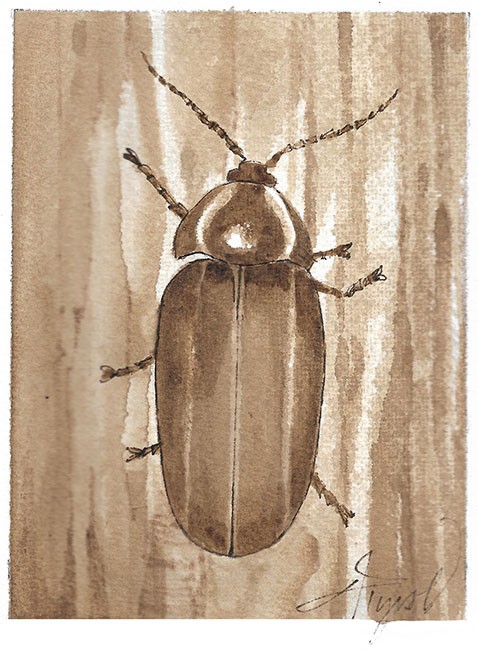
Like most people, I thought I knew where to find fireflies: in back yards and fields on summer nights, flickering on and off like dollhouse-sized lanterns or like Tinkerbell, the tiny fairy that the author of Peter Pan invented while observing fireflies near a Scottish lake.
I was only partly right. There are about 2,000 firefly species, but not all are nocturnal. Nor are they all flashy – some don’t light up at all. Furthermore, we don’t have to wait for summer to see one.
Meet Ellychnia corrusca, known as the winter dark, or diurnal, firefly.
Although common, this insect is easily overlooked. The adult is dark brown or black – about a half inch in length – and has a pair of curved orange markings on the shield covering its head, resembling parentheses. It’s one of the first insects to appear in spring, becoming active as early as late February.
When I first heard of winter dark fireflies, I was intrigued. I was disappointed to learn that they are lanternless – but then, I had no idea how vast and diverse the firefly world was. It was late fall, so I had to wait months before going out hunting. On February 17, I got up close and personal with a big sugar maple, not expecting to find my quarry on the first try. Inspecting the base of the trunk just above the snowline, I immediately spotted a small beetle with orange parentheses on its head, moving slowly about between patches of green lichen.
The winter dark firefly is a contradictory creature, indeed. Common names can be misleading (the dogtooth violet and mountain ash, for example, are members of the lily family and the rose family, respectively); the word firefly is another case in point. Fireflies are not flies. They are soft-bodied, winged beetles, a family of insects in the order Coleoptera.
Unlike most of their relatives, winter dark fireflies overwinter as adults. When the days are noticeably longer and daytime temperatures rise, they begin to climb upward on the deeply grooved bark of trees where they have rested all winter, existing on stored energy reserves. They hang out in ridges and fissures in tree bark, or cluster around sap flows. Maple sugar producers who still use buckets find them floating on the surface of the sap, leading to another common (and less confusing) name: the sap bucket beetle.
As the weather warms and they don’t need to stay on the sunny sides of tree trunks, winter fireflies are often seen flying slowly along in the understory. Mating takes place in the grooves of tree bark from early April through mid-May, and eggs hatch in about 16 days. According to Tufts University professor and firefly expert Sara Lewis, the larvae spend the next 16 months eating, growing, and, well … glowing. This is the one time in a winter firefly’s life that it almost lives up to its name. While adults lack light-producing organs, the larvae are capable of bioluminescence.
During the summer months, winter fireflies are largely absent: adults of the previous season have died off, and larvae of the next generation are hidden in leaf litter and rotting tree trunks.
Fireflies (those with bling and without), fascinate scientists and non-scientists alike. In recent years, concern has risen about diminishing numbers of fireflies in many parts of the world, possibly due to habitat loss, light pollution, agricultural practices, pesticides, and until recently, bounty hunting. (Millions were killed annually and shipped to chemical companies, who extracted luciferase, their light-producing enzyme.) The scientific community is currently collecting population data, as well as studying firefly diets, flash patterns, and other characteristics. One way to help is through citizen science projects, such as iNaturalist.
Finding my first winter firefly was a reminder that I am aware of only a tiny percentage of the infinite number of creatures that surround me. They may not have a delightful song or pretty feathers, but winter dark fireflies are harbingers of spring in the northern woodlands. I’ll be on the lookout for them.


Discussion *